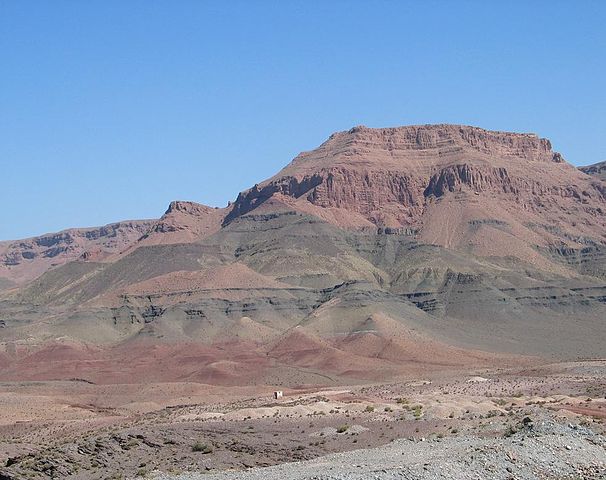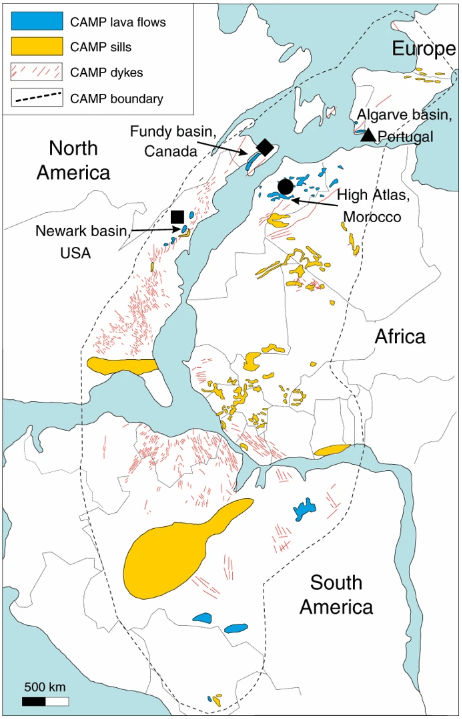200 million years back, a mass extinction event cleaned out about 76%of all species on Earth– both terrestrial and marine.
A brand-new paper shows that pulses of volcanic eruptions were responsible, and that those pulses launched the exact same quantity of CO 2 as human beings are releasing today.
Scientists have been pursuing years to comprehend what could have triggered the J-T termination event. The theoretical causes consist of an asteroid or comet effect, gradual changes in the Earth’s cycles and processes, and volcanic eruptions. The J-T extinction is one of five mass terminations in Earth’s history, and the clinical dispute about the causes is fascinating.
While there’s some proof to support each of those causes, the case for volcanic eruptions is ending up being clearer. In a brand-new paper, a team of scientists points the finger at enormous volcanic eruptions in what is now the Atlantic Ocean.
“CAMP eruptions were quick and potentially catastrophic for both climate and biosphere.”
Capriolo et al, 2020
The paper is entitled “Deep CO 2 in the end-Triassic Central Atlantic Magmatic Province.” The lead author is Manfredo Capriolo from the University of Padolo, in Italy. The paper is released in the journal Nature Communications.
The authors focused on what are called Large Igneous Provinces, or LIPs.
Image Credit: By Williamborg– Own work, CC BY-SA 3.0, https://commons.wikimedia.org/w/index.php?curid=26290915
At the time of the J-T termination, Earth’s land mass was one big continent called Pangaea.



Volcanic eruptions from Big Igneous Provinces correspond with mass terminations during the Phanerozoic era.
Since eruptions coincide with terminations, it recommends a cause-effect relationship. To investigate that relationship, the authors examined the nature and the timing of the rock extruded to the surface area during those eruptions. As the authors compose in their introduction: “In order to totally comprehend this relationship, it is needed to constrain the amount and kind of degassed magmatic volatiles, and to figure out the depth of their source and the timing of eruption.”
The authors took a look at over 200 samples of basaltic lava circulations and sills in the CAMP. There are a host of chemicals launched during eruptions that can damage the environment and climate. They include CO, CO 2, CH 4, SO 2, H 2 S, HCl, and CH 3 Cl. The team of scientists were primarily worried about CO 2



Their outcomes recommend that the CAMP produced as much as 100,000 gigatons of CO 2 and that part of that came from the middle-lower crust and mantle. The origins of that co2 are essential, due to the fact that it recommends that the eruptions were really fast, and disastrous. The scientists say that the eruptions were like noticable “pulses” of CO 2 Since those pulses were so fast, they overwhelmed the Earth’s capacity to re-absorb it. “CAMP eruptions were fast and potentially catastrophic for both environment and biosphere.”
The pulsing nature of these eruptions made them particularly destructive. The pulses were triggered by bubbles of CO 2 and essential carbon in Earth’s “transcrustal magmatic plumbing system” according to the paper.
The magma was filled with CO 2 and “can describe the pulsed eruptive style of CAMP, where CO 2 functions as propellant for lava ascent, causing rapid and violent eruptive pulses.” The authors indicate the nature of some modern-day eruptions in Hawaii, where high concentrations of CO 2 in the basalt caused magma to increase over 5 km to the surface area, and to imitate fountains when it erupted.
In the conclusion of the paper the authors point out that the quantity of CO 2 produced in these eruptions is approximately equivalent to the quantity of CO 2 launched into the environment by humans in the 21 st century. Even a single pulse might have done so.
” In fact, a single brief CAMP magmatic pulse … may release about 5?1016?
So there we have it. We’re handling to release as much CO 2 as a single, huge volcanic pulse did hundreds of countless years back. “This situation for fast CO 2 emissions forecasts a global temperature increase of about 2? ° C and an oceanic pH decline of about 0.15 units over 0.1 kyrs, and suggests that the end-Triassic weather and environmental changes, driven by CO 2 emissions, may have resembled those predicted for the near future.”
People who do not believe the science behind human-caused environment change typically point to volcanoes as the genuine offenders. Earth shops a huge amount of carbon in rock– much more than in the oceans or the atmosphere. And while some of it gets away into the environment from volcanoes, volcanic emissions of CO 2 in our age are small compared to human emissions.
Eruptions in Iceland and in other places can curtail airline company traffic for a while, and they appear impressive. However modern eruptions do not come close to those at the time of the J-T termination.
It’s our emissions that are driving global climate modification, and as rigorous science like this research study shows us, the consequences can be alarming.
More:
- Term Paper: Deep CO 2 in the end-Triassic Central Atlantic Magmatic Province
- Wikipedia: Triassic– Jurassic extinction occasion
- Universe Today: A Rapid Increase in Temperature Level Led to the Worst Termination in our World’s History

